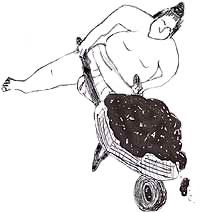Gardening is a Sport
I recently concluded that gardening is a sport. It is seasonal, like many sports. We have specialized tools and an entourage of hats, gloves and knee pads just like any well-equipped sport. We sweat as much as any athlete during the height of their competition. Serious gardeners do intense workouts. We don't need fancy weight machines in our homes, or expensive health clubs. Unlike going to a health club, we actually accomplish something while keeping our bodies in shape. Instead of lifting weights, we lift soil, manure and compost by the yard-full. We pick up heavy rocks, containers and cubits of wet potting soil.

The competition is fierce. We play a defensive position—like a goalie in soccer—holding weeds back from achieving a final score. We play offense, taking territory back from the wild things that grow on our property. We may not be offensive linemen on a football team, pushing back the defense, but we push mowers and wheelbarrows.
Like a Japanese Sumo wrestler using hataki-komi—a side step and push—we balance overloaded wheelbarrows. Unlike the trained wrestler, we don't put much ceremony in lifting the heavy and awkward loads. We look like we are doing the Sumo's ceremonial dance at the beginning of a match, lifting one leg sideways, rocking our bodies in the opposite direction, precariously balancing hefty materials on one wheel.
This could be you at a time when a rarely invoked shini-tai (end of match) should be called because you are in an impossible position from which to fight a heavy burden. The wheelbarrow knows when to quit, unceremoniously tipping sideways and relieving itself of the burden. If your backs, legs, arms or shoulders collapse, you may be out with injuries for the rest of the season.
Avoid Injury this Autumn With These Simple Tips
Garden Fitness Stretches
- Before stretching for any activity, breathe in and out, slowly and rhythmically; do not bounce or jerk your body, and stretch as far and as comfortably as you can. Do not follow the "no pain, no gain" rule. Stretching should not be painful.
- While sitting, prop your heel on a stool or step, keeping the knees straight. Lean forward until you feel a stretch in the back of the thigh, or the hamstring muscle. Hold this position for 15 seconds. Do this once more and repeat with the other leg.
- Stand up, balance yourself, and grab the front of your ankle from behind. Pull your heel towards your buttocks and hold the position for 15 seconds. Do this again and repeat with the other leg.
- While standing, weave your fingers together above your head with the palms up. Lean to one side for 10 seconds, then to the other. Repeat this stretch three times.
- Do the "Hug your best friend." Wrap your arms around yourself and rotate to one side, stretching as far as you can comfortably go. Hold for 10 seconds and reverse. Repeat two or three times.
Like athletes, we can injure ourselves, because unlike the wheelbarrow, we don't always acknowledge our limits. We may not know how to throw a fast ball, or tackle a running back, but we toss dirt clods and rocks, wrestling our gardens into shape.
When I went to my chiropractor for shoulder pain that wouldn't go away, I was diagnosed with an injury usually relegated to baseball pitchers. An injury like mine wasn't from throwing a fast ball at an imaginary brave batter. The actual cause is unclear; however, the kind of work I was doing in the garden is most likely the source. I picked up too many one-man rocks from a half-man rock pile, or maybe I moved right when left was the best option. Other reasons for the injury may stem from not warming up properly, not stretching, or pushing my body past its physical limits.
It is easy to injure ourselves with heavy chores, yet even light chores and repetitious motion can cause harm. Twisting, bending, turning or reaching during garden activities can cause soreness or injury, especially if you don't do stretches and warm-up exercises before your garden workout. President of the American Chiropractic Association, Dr. Michael Pedigo says, “A warm-up and cool-down period is as important in gardening as it is for any physical activity.” Simple stretches before, during and after your chores lessen the chance of injuries, while reducing stiffness and soreness. Dr. Lamar, a chiropractor in Kingston, Washington warns, “Don't twist at the waist; move your whole body as a unit when shoveling or lifting loads.” Start out slow and work your way up to activities you haven't done in awhile. When asked if he saw more garden related injuries in fall or spring, Dr. Lamar replied, “Absolutely! Even after a few weeks of bad weather, the first nice day the weekend warriors head outdoors and do more than their bodies are ready for.”
Before you begin any garden chore, stretch for 10-15 minutes. Some time during the chores and after you finish, repeat your stretches. Try not to overdo it at first; however, if you find yourself stiff or sore after working in the garden, use ice packs to help with the discomfort.
As I found out the hard way, it is easier to take care of your body than heal from harm our sport can inflict upon us. Take care of yourself! Don't let an injury keep you from signing on for another season of gardening.
|
Raking Tips
|
Debbie Teashon.

Gardening for the Homebrewer: Grow and Process Plants for Making Beer, Wine, Gruit, Cider, Perry, and More
By co-authors Debbie Teashon (Rainy Side Gardeners) and Wendy Tweton
Copyright Notice | Home | Search | Archives

